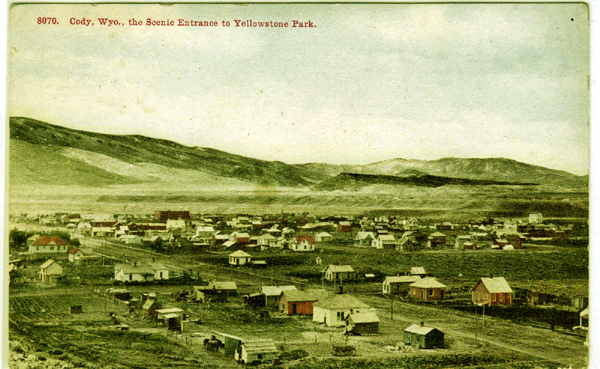Dating of the above photo is based on the
dates of indivual buildings and the water tank on South Hill. In the above image, the newly constructed water tank is visible on the hill. Whisps of smoke from an arriving train on the
extreme right, drift across the background. Further in the background the Absarokas are obscured by a haze.
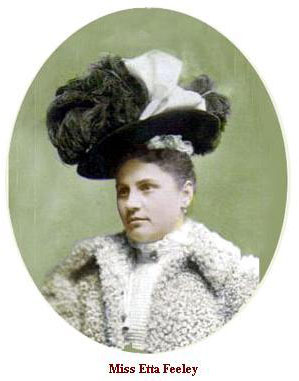
On the edge of town near the end of Bleistein Avenue was an area known as the "Scarlet Way." The center of the Scarlet Way was a big white house on Lots 8 and 9 Block 1 occupied by Etta Feeley (1871-1960). Miss Etta's house
was one in which in which lonely sheepherders, cowboys and boys workin on Col. Cody's
irrigation project could take their ease. Immediately to the east of Miss Etta's establishment on Lots 12 and 13 Block 1 was a one-story house sometimes referred to as the
"green house" operated
by Miss Ollie Archer. An inventory of the furnishings of Miss Archer's facility appearing in the Stockgrower and Farmer reflected that the house contained
ten bedroom sets and a piano. About a block away on Salsbury was another house operated by Miss Cassie Waters. Miss Etta's establishment was operated from 1902 to 1910.
"Feeley" was not her real name of course. It was, however,
her professional name which she used on occupational licenses and in court. Her real name changed several times as she went through several marriages. Miss Cassie also
regularly changed her name and was also known as Cassie La Fay and Cassie McGhan. The three facilities were also licensed as saloons but in other documents
referred to as "female boarding houses".
Miss Etta had previously operated a similar
establishment in Montana. There, it was apparently a high class facility. In 1895 she was advertising in the Anaconda Standard that she needed a
piano player. In 1902 in Cody, she applied for and paid for an occupational license as a "saloon." Of course, there were other saloons. The cost of the
occupational license was $300.00. Although licensed as a
saloon the facility was, as described by the Dispatch, Feb. 7, 1902, a "house of ill shape [sic]." It may, however,
been a typographical error, in that the next month the paper referred to it as being "occupied for purposes of ill fame."
See Dispatch, March 14, 1902. Almost immediately Miss Etta ran into legal problems. She was sued by Maggie Jess for $200 for alleged
unlawful detention of premises. Miss Maggie operated a similar type of establishment on Laurel Avenue in Buffalo. Miss Maggie purchased the property
leased by Miss Etta, but the purchase did not eliminate Miss Etta's leasehold estate and ultimately Miss Maggie's lawsuit was dismissed.
Jake Schwoob sued her on an account. Criminal proceedings were brought in the name of the
State charging Miss Etta with criminal detainer, criminal tresspass, and selling liquor without a license in Cody, and selling liquor without a license in
Garland. All of the charges and suits were dismissed. See Dispatch, March 14, 1902 and April 17, 1902.
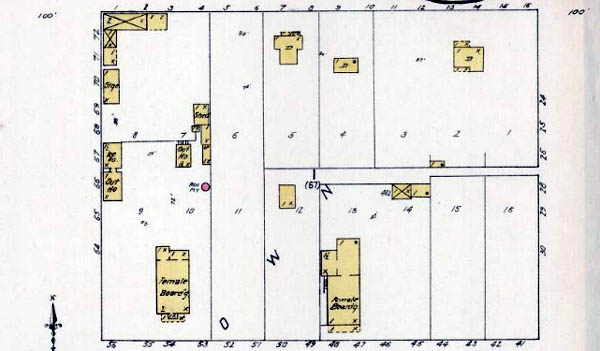
Sanborn May Block 1, 1912 showing location of
Miss Etta's and Miss Ollie's facilities.
There was a certain degree of revelry [and rivalry] going on in the female boarding houses. Miss Ollie's seems to have had a more sporting air. One young cowboy
came to the bright lights of Cody and met two men
who he knew by name. They took him to several saloons. Sir Harry Lauder, a Scotish music call singer, used to sing a song of the
farmer who used to hang his trousers on the back of the bedroom door and in the morning when he awoke was stony broke.
Our young cowboy when he awoke in a strange bed with no idea of how he got there, found he had been relieved
of $110.00. He thought that the women had taken his money. He shot the place up and his money was returned. In the process of being taken before the
judge he was wounded in the leg. He was fined $5.00 and costs were assessed in the amount of
$3.00 together with a lecture from the judge.
Generally, houses of ill repute were illegal in Wyoming. See Compiled General Statutes, 1910, Section 5905. But violation of the statute
was difficult to prove. See. Konepisos vs. State, 26 Wyo. 350, 185 Pac. 354, (1919). A disincentive to enforcement of the
law was the revenue devrived by the local community. By 1910, the license fee to Park County was $1,000 equal with inflation as of June 2014 to some $24,075.
Additionally, Miss Etta had to pay various fines levied by the local court. Allegedly in one month Miss Etta paid
$300 in fines. Miss Etta apparently took the hint and opened a facility in Sheridan. Miss Etta's difficulties with Cody officials may have been motivated by the
construction of a nearby new school. A block away from Miss Etta's White House was another factility on Salsbury owned by Miss Cassie Waters which also had to move.
Miss Cassie moved further away from the school.
As to Miss Etta's Sheridan establishment, the Sheridan Post, Nov. 6, 1911, reported that one of her girls,
Veta O. "Rabbit" Blines, committed suicide by drinking carbolic acid. In 1915, Miss Etta was charged wtih selling liquor to an American Indian. See Sheridan Post, March 26, 1915.
She defended on the basis that she did not know the individual was an Indian, she thought him to be Mexican. The noted that the individual spoke
English better than most whites. The trial court held that it was irrelevnt whether Miss Etta knew the indivdual was an Indian. Serving the
alcohol to an Indian whether she knew the individual was an Indian or not was illegal. Miss Etta appealed her conviction to the
United State Court of Appeals in Denver. The appeal was denied. See Feeley vs. United States, 236 Fed. 903 (8th Cir. 1916).
In the meantime in Buffalo, Miss Maggie had her own difficulties. In 1895, she faced a foreclosure sale. In 1911, the School Board requested that
the Town close her down. Apparently no action was taken. She was still open as late as 1918.
Ultimately Miss Maggie moved to Pensylvania.
Miss Cassie was involved in the fall from grace of Cody's one-time popular physician Dr. William Sabin Bennett. Dr. Bennett came to Cody in 1904 from Meeteetse.
In Cody, he established a medical practice and owned a drugstore and
jewelry store. He was on the official welcoming party for Prince Albert of Monaco. and New York Mayor John Purroy Mitchel(1879-1918), the "Boy Mayor." Mayor Mitchel had been invited to
Dody by A. A. Anderson for hunting. Not withstanding that for almost the entire time Mayor Mitchel was in the Cody area he was hunting, he alleged only got one bear.Mitchel was defeated for re-election. He then enlisted in the
predecessor the Army Air Corps. He was killed on July 6, 1918 when on a routine training flight he fell out of his aeroplane. He had forgotten to fasten his seat belt.
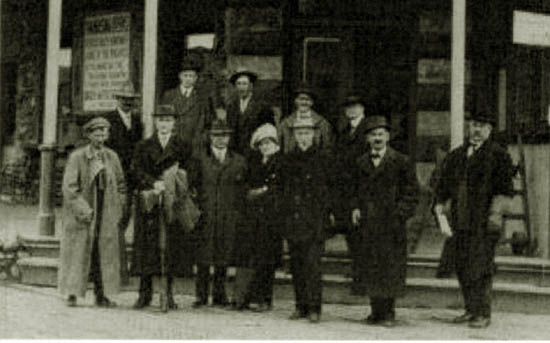
Official Welcoming party for New York Mayor John P. Mitchel on steps of Irma Hotel, 1915. Mayor and Mrs. Mitchel in center. G. T. Beck on extreme right, Cody Mayor
William S. Bennett to the left of Beck.
Dr. Bennett was able to send his three boys to Ivy League colleges, Yale, Cornell, and Colgate. Following college,
William, Jr. became a lawyer with the United States Attorney's office in Denver.
In Cody for Dr. Bennett it was life in the fast lane, not just in his high-powered motor cars in which he had numerous single car accidents as a result of driving too
fast on the narrow bad roads of the time, but in his business and personal life. He served at different times on the school board, as Mayor of Cody, legislator and was appointed
County Health Officer. He was active in the Masonic Order, He invested in mining projects in Nevada and New Mexico. It was like an individual the writer knew quite some years ago who was in
the timber and sawmill industry, was president of a
bank, chairman of a local govenmental agency and was on the board of directors of the local electric co-op. He was leveraged to the hilt. At lunch when he picked up his sandwich,
it was shaking visibly. In landing his airplane one day, he forgot to lower the
wheels. He survived, but it became obvious that keeping all the balls in the air was getting difficult. One day, he dropped a ball. They all fell,
the individual moved to Brazil to work for someone who formerly had been a customer.
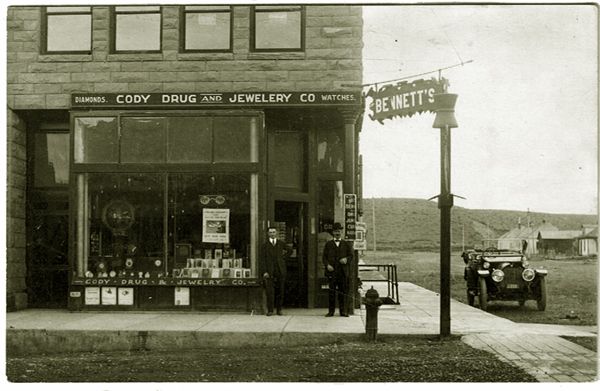
Dr. Bennett's Jewelry store and drug store, approx. 1915. Dr. Bennett on right. Man on the left
believed to be Jay Powers, the pharmacist and store manager. Powers was a relative of Mrs. Bennett. He left in 1916 to go to medical school. The car on the right is
is Dr. Bennett's Hudson phaeton.
Maybe to relieve the stress, Dr. Bennett became besmitten with Miss Cassie. It would not decorious to be seen entering
Miss Cassie's house. Instead there were dalliances out in the country in Miss Cassie's tepee. In a small town
everyone recognizes everyone else's car. And certainly no one would overlook Dr. Bennett's Hudson Super Six Speedser Phaeton. It replaced an earlier
Hudson. The Hudson Motor Car Company advertised that the Super Six was capable of 102 1/2 miles per hour. Dr. Bennett got the car stuck
during one tete a tete off the old South Fork Road.
Rumors abounded. A final straw may have been when he purchased identical dresses for
his wife and for Miss Cassie -- and the two met at the post office each wearing the same dress.
Dr. Bennett moved from Cody to Greybull and attepted to re-establish his medical practice there. Four months later
he was thinking of moving his practice to Montana. He and a Mrs. St. Clair, were caught registered under ficticous names in a hotel
in Lodge Grass, Montana. In Sheridan, the two were caught at 3:45 a.m. in the same hotel room in
the Sheridan Inn, she in a negligee. Mrs. St. Clair attempted to depart the room by way of a window. Dr. Bennett claimed nothing untoward happened.
He said had become ill and that he had called
Mrs. St. Clair to minister to him. As a result of the notoriety, plans to move to Lodge Grass fell through.
The Cody Club passed a resolution directed to Governor Carey for whom one of Dr. Bennett's sons worked as an aide. The resolution, which minced no words, requested that the
Governor remove Dr. Webster as health officer for Park County. The incident at the Sheridan Inn
came to the attention of the United States Attorney in Denver. Dr. Bennett was indicted for violation of the Mann Act, which made it a felony to transport
a woman across a state line for an "immoral purpose.". At the first trial in
Cheyenne there was a "hung jury." The case was set for a second trial eventually set for 1924. In March 1924 before his case would come up for trial, Dr. Bennett traveled to Ely, Nevada, where he had mining interests.
The mining interests were not going well. Mining equipment had not been paid for. He was sued by the equipment manufacturer. See Richmond Machinery Co. v.
Benett, 229 Pac 1099 (Nev. 1925). Ten days after his arrival in Nevada, Dr. Bennett was dead, dead, according to the death
certificate, from "alcoholism (chronic)" with a contributary cause of "moonshine." Dr. Bennett's son, William, traveled to Ely to claim the body which was interred in
Ely.
